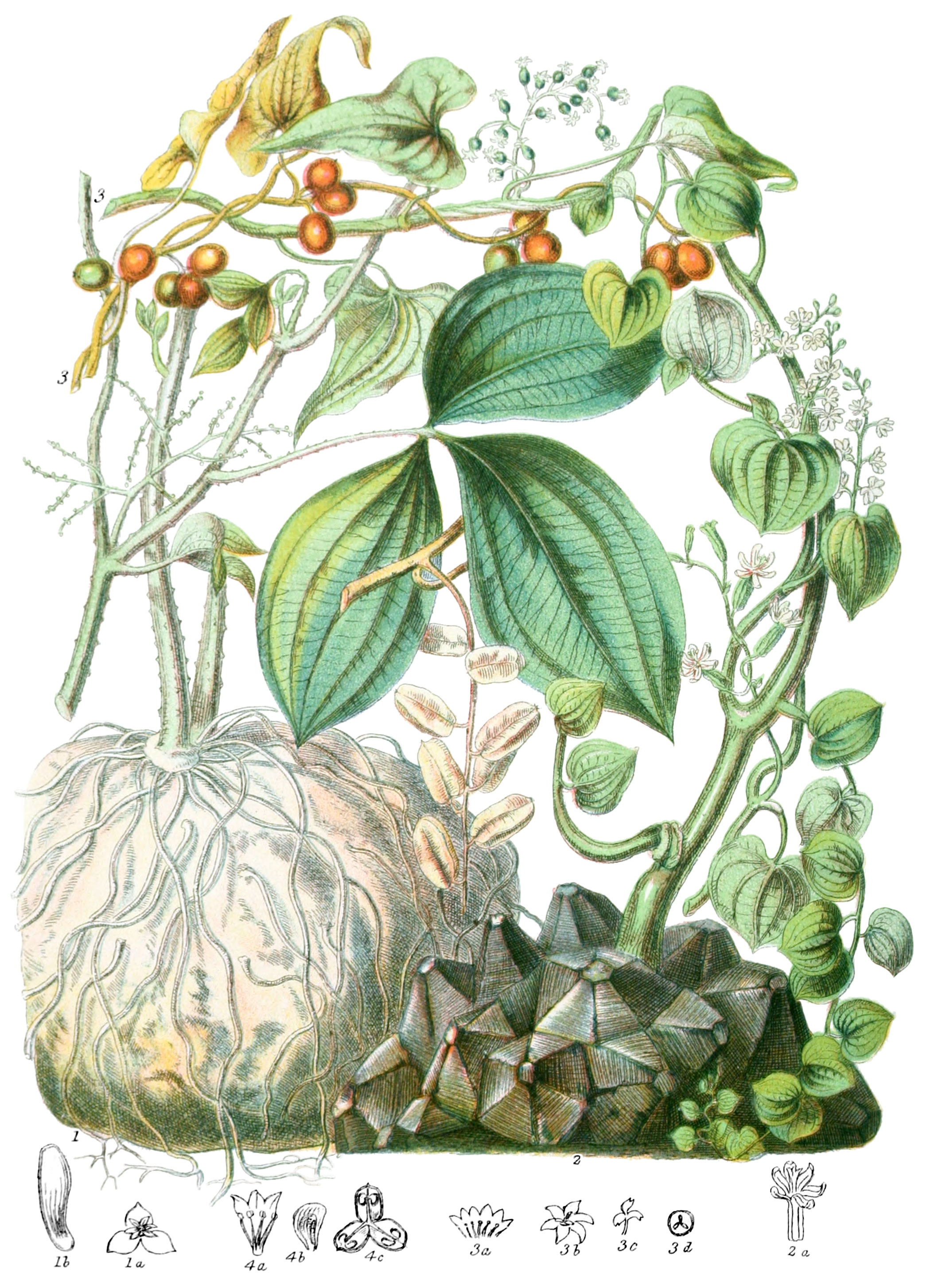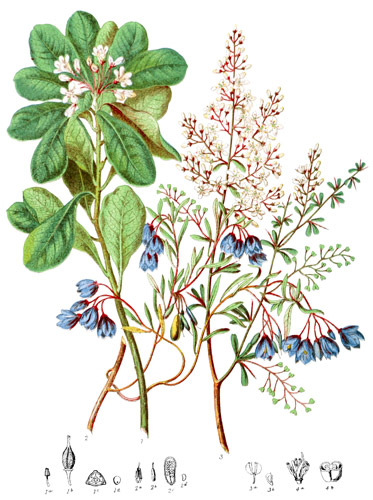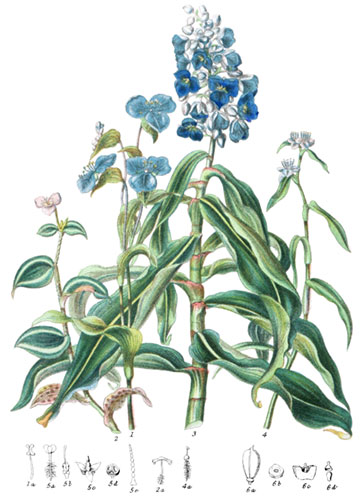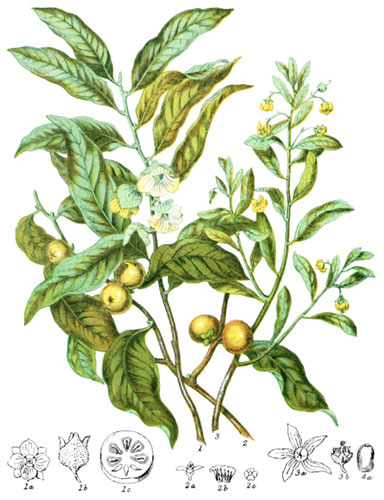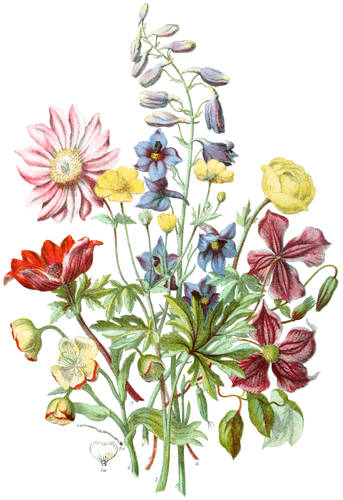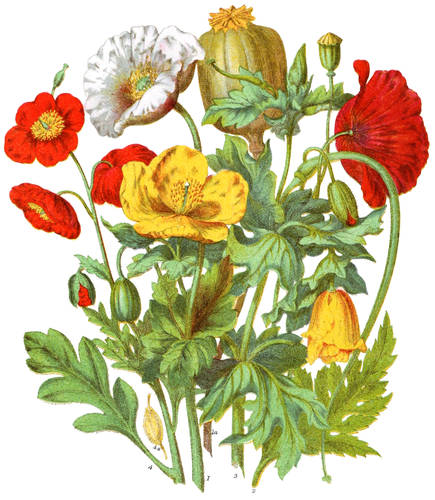Key characteristics
Twining shrubs, having large tubers above or below the ground. The leaves are alternate, or occasionally opposite, with netted veins. The flowers are small, spiked, with from one to three bracts. The stamens and pistil are in separate flowers. The calyx and corolla are united, herbaceous and adherent. The stamens are six, inserted into the base of the sepals and petals. The anthers are turned inwards and burst lengthwise. The ovary is three-celled, with one or two seeds in each cell. The style is deeply three-cleft. The fruit is a capsule or a berry, leafy or compressed, or succulent. The seeds of the capsule are flattened, winged or wingless, those of the berry round; they contain cartilaginous albumen, in a cavity of which lies the embryo.
This Tribe has affinity with Smilaceæ.
An acrid principle exists generally in these plants.
Select plants in this order
Not all plants listed are illustrated and not all plants illustrated are listed.
- Dioscorea records the name of the celebrated Greek physician and botanist, Dioscorides. It is an important genus, yielding an bundant supply of nutriment in its farinaceous tubers: D. sativa is the common Yam, cultivated as the chief food of Negroes in Africa and the West Indies. The acrid juice is entirely expelled by heat, and the mealy tubers are excellent, either roasted or boilded. The flour is also made into cakes and bread.
- D. aculeata is a variety cultivated in all the islands of the torrid zone, as well as in New Zealand. The buds of the tubers are planted like those of the potato, and require very little care afterwards, producing plentiful crops.
- D. triphylla (1) is of a noxious nature, and the tubers contain to much acrid principle to be made available for food.
- D. versicolor is one of the many species common in India, in the valleys, and ascending as high as 5000 feet on the Himalayas.
- D. alata, the most frequently cultivated in northern India, displays in its stem very distinctly the peculiar arrangement of wedges of the wood placed against its bark, which, when dried, easily separate, like those of Aristolochia and Menispermum.
- The varities of Dioscorea in the East have attracted the attention of all botanical travellers. Rumphus describes some with spreading branched tubers, others twisted like a snake. The size and weight vary extremely; some not more than a pound in weight, others as much as a foot broad.
- D. atro-purpurea is extensively grown in Malacca and the isles of the Indian Archipelago.
- D. bulbifera is the Yam of Otaheite; at the base of the leaf-stalks are small bulbs, containing the gem of new plants.
- Testitudinaria (2) was so named because of the root having the appearance of the shell of a tortoise. This singular root-stock grows to an immense size in favourable localities, and contains a farinaceous substance used by the Hottentots as food in time of scarcity, whence it is commonly called Hottentot’s breat. It grows readily in a conservatory, and has a remarkable appearance, the extremely slender stems rising out of the rugged mass, and climbing to a considerable height over some support.
- Tamus communis (3) is of some interest, as being the only European example of this Tribe of plants. It is frequently seen in this country climbing with twining stems without tendrils, over hedges and bushes in woods and groves, adorning them in spring with its delicate pale-green flowers, and with its bright red berries in autumn. On the roots are large dark excrescences, of such acrid properties that they have been used as blisters; the roots themselves contain a white starchy substance of a wholesome nature; the young shoots ar emild, and are eaten by the Moors with oil and salt.
- Rayania was named after the learned naturalist Ray; the genus belongs chiefly to the West Indies, a graceful twining plant, like the rest, with drooping clusters of winged capsules, bearing one seed each.
- Oncus esculentus of Cochin-China has eatable tubers.
Locations
The numerous species of this Tribe are found exclusively in the Tropics, excepting Tamus, which is a native of the Temperate parts of Asia, and of Europe.
Legend
- Dioscorea triphylla, Three-leaved Yam. Malabar.
- Pistil Flower, magnified.
- Seed, magnified.
- Testitudinaria elephantipes, Elephant’s-foot. Cape of Good Hope.
- Pistil Flower.
- Tamus communis, Black Bryony. Hedges, England.
- Stamen Flower.
- Pistil Flower.
- Pistil.
- Section of Ovary.
-
- Dioscorea adenocarpa. Section of Stamen Flower.
- Seed, magnified.
- Seed-vessel, open.
Explore more
Posters
Decorate your walls with colorful detailed posters based on Elizabeth Twining’s beautiful two-volume set from 1868.
Puzzles
Challenge yourself or someone else to assemble a puzzle of all 160 botanical illustrations.
